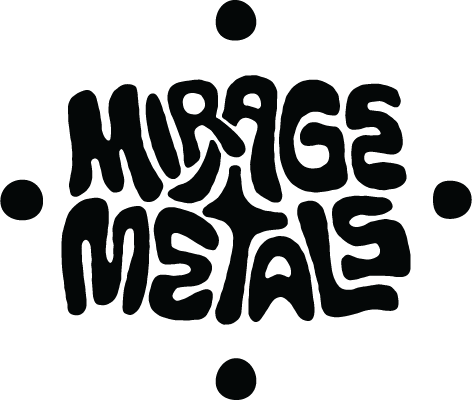People are naturally drawn to stones. There's just something about a neat looking rock... As I've grown more familiar with purchasing stones, I've also begun to question the social and environmental impacts of our collections. The mining and cutting of stones can be secretive and dangerous, making ethical sourcing an ongoing challenge.
It is my priority to create jewelry that supports the fair treatment of the people involved along each point in the supply chain.
We select stones based on the traceability of origin and cutting. At times designs use rough stones, which do not require cutting and polishing - an area of concern over worker wellbeing, due to the dust involved. Stones that have been cut and polished come from independent US-based lapidary artists, or an ethical supplier that uses their own safe stone-cutting facilities.
Occasionally, we design with "old stock" stones, purchased from retired artists or collectors. This breathes a new life into materials that may have been lost in storage otherwise.
While I have updated my purchasing criteria, it will take time before each piece meets these standards. It is important to me to be transparent in this transition, so check for individual stone information in each listing, and please reach out with any questions.
I do not recommend wearing stones in water. Whether it be the salt of the ocean or your favorite soap in a bath - moisture and the elements within may cause discoloration or dull the luster of natural stones.
Sterling Silver
A classic jewelry material.
If you know jewelry, you know sterling silver. A versatile material with a long history, sterling silver is consistent, reasonably durable, and undeniably beautiful. You may have noticed a small stamp that reads “.925” on pieces piled in your grandmother’s jewelry box, but do you know what that stands for? Sterling silver is 92.5% pure silver, with a few other metals added to the mix for strength. It can tarnish over time, as it is exposed to life and its elements (hey, we can relate…). This natural oxidation shows up as dark staining on the surface of your jewelry. But not to worry! Tarnish is harmless and in most cases, can be quickly buffed away with a polishing cloth. Sterling silver is a classic for a reason, and since it has no plating, can last a lifetime with proper care.
Argentium Silver
Recycled silver with a long-lasting luster.
Sterling has stayed popular for good reason, but argentium silver is quickly becoming our new favorite. We like to think of it as sterling’s effortlessly cool cousin - a friendly, low maintenance cutie. While they are very similar materials, the addition of geranium in argentium silver brings some unique perks.
Most notably, argentium stays bright longer than traditional sterling, and requires less polishing to maintain its silver sparkle. This is especially beneficial for chains, which can be tricky (although certainly not impossible!) to polish if they become tarnished due to the tight spaces.
While it is rare, some people are unable to wear sterling silver due to skin sensitivities. They may find argentium to be a hypoallergenic alternative!
Along with those benefits, argentium is always made using recycled silver. While I believe recycled metal has its merits, I am also aware that it is not a complete answer to the question of sustainability in jewelry. Because of this, I seek out other sustainability strategies as well.
14/20 Gold Fill:
A quality, affordable alternative to solid gold.
Simply put, gold filled metal is the step between gold plating and solid gold. Gold fill refers to a core of brass with a layer of gold pressure bonded to the outside. Unlike gold plated metals, gold fill metal is required to be 5% gold by weight. Avoid using polishing cloths on gold-fill, as they contain a mild abrasive that can wear away the gold. Instead, use a soft cloth or wash with mild soap and water. Our gold fill wire is made in the United States.
Chains + Clasps:
All of our clasps and chains are made in the US or Italy.
Chains and clasps are made from traditional sterling silver, unless specified otherwise.
In 2023 we added an argentium chain option, which uses recycled silver. Clasps and findings on these chains are also made of argentium silver.
We will continue to seek more recycled options.
Each order is carefully packaged to arrive on your doorstep in low-waste, eco-friendly style. Every piece of the shipping puzzle has been considered, and is either made from natural fiber + reusable, or fully recyclable.
We use recycled shipping boxes from EcoEnclose, which is a local Colorado business, and seal them up with plastic-free kraft paper tape. Our care and contact cards are printed on 100% recycled kraft paper.
Each order includes a cotton pouch and jewelry box. The cotton pouches were dyed with natural cutch bark and black mallow flowers by local artist Indigo & Goldenrod. Each one is a unique work of art and I am so excited to share them with you.
Our new, customized jewelry boxes are made from FSC-certified paperboard, with a simple logo imprint. The protective cushion inside is made from a wood-pulp material instead of the usual synthetic foam found in most jewelry boxes. I searched for a long time before finding this alternative, and am so glad we held out for it!
I encourage you to reuse first, then recycle.
I work with care and intention to avoid unnecessary waste. I use every scrap of metal that I can, and save any leftovers that are too small to use to be refined and recycled. Even with care, jewelry studios are dirty places, and precious metals are found in unexpected spots - like our floor dust and paper towels. Studio sweeps (dust, metal shavings, and waste containing even a small amount of metal) are collected and donated to a program which refines precious metal to raise funds for emergency support to artists (Sweeps for CERF).
Inevitably, some materials and supplies arrive packaged in plastic bags or on plastic spools, which are not curbside recyclable. I do my best to reuse these, and when possible I purchase supplies in bulk to minimize this waste source. I save any recyclable plastics to drop off at our local center.

